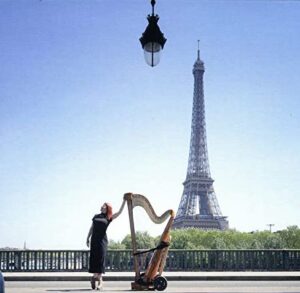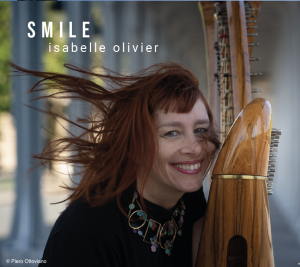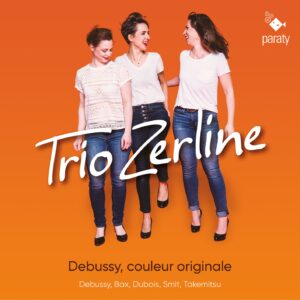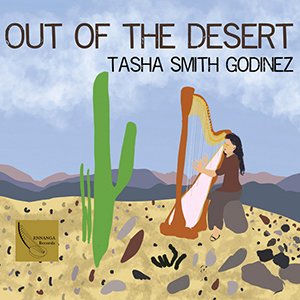
Harpmuziek komen we relatief weinig tegen. Natuurlijk, de Zwitserse harpist Andreas Vollenweider gaf de harpmuziek een enorme boost, net zoals de Bretonse musicus Alan Stivell, de Ierse Moya Brennan (van de groep Clannad) en natuurlijk de Nederlandse harpiste Lavinia Meijer. We komen de harp onder andere ook tegen in Colombia en Mexico in de joropo, waar de harp hèt belangrijkste instrument is. Maar over het algemeen blijft de harp toch in de (orkest)achtergrond….
English version below
Maar de afgelopen maanden zijn er drie albums uitgebracht waar de harp de ziel is van de muziek. Smile van de Franse harpiste Isabelle Olivier, het album Debussy, Couleur Originale van het Franse Trio Zerline waarop klassiek werk te horen is, gecomponeerd voor harp, fluit en altviool en Out of the Desert van de Amerikaanse harpiste Tasha Smith Godinez.
 Het album Smile van Isabelle Oliver is een ode aan Charlie Chaplin en refereert aan het lied Smile dat hij in 1936 schreef. In veelal zelf gecomponeerd werk horen we de veelzijdige musicus Olivier die fraaie melodische thematiek voorziet van originele arrangementen. Accordeon (sferisch spel in Light), piano (lekker modale solo in Cuban Smile), gitaar, drums/percussie en elektronica zijn de smaakmakers. De stukken hebben een warm karakter. Op innemende wijze vult dit divers instrumentarium de harp aan, zoals het gitaarwerk in Aroma, wat als een vlechtwerk om de harp-arpeggio’s heen krult. Alle stukken zijn eigenlijk liedjes zonder woorden, gecomponeerd en gearrangeerd vanuit de melodie, op 2 na, die echt worden gezongen. Smile staat vol gedurfde composities in een gevarieerde eenvoud, met avontuurlijke uitstapjes naar jazz en geïmproviseerde muziek.
Het album Smile van Isabelle Oliver is een ode aan Charlie Chaplin en refereert aan het lied Smile dat hij in 1936 schreef. In veelal zelf gecomponeerd werk horen we de veelzijdige musicus Olivier die fraaie melodische thematiek voorziet van originele arrangementen. Accordeon (sferisch spel in Light), piano (lekker modale solo in Cuban Smile), gitaar, drums/percussie en elektronica zijn de smaakmakers. De stukken hebben een warm karakter. Op innemende wijze vult dit divers instrumentarium de harp aan, zoals het gitaarwerk in Aroma, wat als een vlechtwerk om de harp-arpeggio’s heen krult. Alle stukken zijn eigenlijk liedjes zonder woorden, gecomponeerd en gearrangeerd vanuit de melodie, op 2 na, die echt worden gezongen. Smile staat vol gedurfde composities in een gevarieerde eenvoud, met avontuurlijke uitstapjes naar jazz en geïmproviseerde muziek.
 Alhoewel componist Théodore Dubois de eerste was die een trio schreef voor altviool, fluit en harp, is Debussy de bekendste die deze instrumentatie toepaste in zijn Sonate, het openingswerk van de CD Debussy, Couleur Originale van Trio Zerline. Deze instrumentatie is uniek en er is weinig repertoire beschikbaar in deze bezetting. De composities die er zijn, zijn modern of worden gecomponeerd in opdracht van het trio. Op dit album horen we naast Debussy en het lieflijke en aimabele Terzetto met fraaie imitaties van Dubois, ook werk van Arnold Bax, Leo Smit en Töru Takemitsu. Allen 20ste eeuwse componisten die verschillende compositie-technieken toepassen zoals imitatie, solo-passages, variaties en complementaire harmonische zettingen. De diversiteit vergt veel van de musici. Zij moeten zich steeds bewust zijn van hun rol binnen de compositie. De musici van het Trio Zerline zijn vakbekwaam en benaderen de stukken met souplesse en passen zich met gemak aan, aan deze afwisseling. Zeker het werk Trio van Leo Smit (1900/1943), dat hier en daar zelfs kleine orkestrale vormen aanneemt met dissonante harmonieën en virtuoze passages. Dat deze drie musici genieten van de veelzijdigheid binnen de muziek is overduidelijk en komt bijzonder goed tot zijn recht op hun nieuwe album Debussy, Couleur Originale.
Alhoewel componist Théodore Dubois de eerste was die een trio schreef voor altviool, fluit en harp, is Debussy de bekendste die deze instrumentatie toepaste in zijn Sonate, het openingswerk van de CD Debussy, Couleur Originale van Trio Zerline. Deze instrumentatie is uniek en er is weinig repertoire beschikbaar in deze bezetting. De composities die er zijn, zijn modern of worden gecomponeerd in opdracht van het trio. Op dit album horen we naast Debussy en het lieflijke en aimabele Terzetto met fraaie imitaties van Dubois, ook werk van Arnold Bax, Leo Smit en Töru Takemitsu. Allen 20ste eeuwse componisten die verschillende compositie-technieken toepassen zoals imitatie, solo-passages, variaties en complementaire harmonische zettingen. De diversiteit vergt veel van de musici. Zij moeten zich steeds bewust zijn van hun rol binnen de compositie. De musici van het Trio Zerline zijn vakbekwaam en benaderen de stukken met souplesse en passen zich met gemak aan, aan deze afwisseling. Zeker het werk Trio van Leo Smit (1900/1943), dat hier en daar zelfs kleine orkestrale vormen aanneemt met dissonante harmonieën en virtuoze passages. Dat deze drie musici genieten van de veelzijdigheid binnen de muziek is overduidelijk en komt bijzonder goed tot zijn recht op hun nieuwe album Debussy, Couleur Originale.
 De Amerikaanse harpiste Tasha Smith Godinez (San Diego) draagt haar album Out of the Desert op aan haar familie. Haar (groot)ouders, kinderen en haar man. Ze wordt bijgestaan door een percussionist en een altviolist. De muziek heeft een peinzend en soms wat dromerig karakter. In de ensemble-stukken gebruikt ze veel arpeggio’s die de muziek weelderig en rijk maakt, aangevuld met strakke percussie en levendig altviool-spel. De solostukken zijn langzaam, met een kalme melodie waarin je wordt meegenomen naar het broeierige achterland van Californië. Haar composities zijn spannend en vindingrijk en worden hier en daar gelardeerd met buitenmuzikale geluiden zoals de wind, verkeer, vogels of kinderstemmen. Out of the Desert is een filosofisch album, een reflectie op de tijd dat de wereld stilstond vanwege de pandemie en zelfreflectie enig soelaas bood en prachtige muziek heeft opgeleverd.
De Amerikaanse harpiste Tasha Smith Godinez (San Diego) draagt haar album Out of the Desert op aan haar familie. Haar (groot)ouders, kinderen en haar man. Ze wordt bijgestaan door een percussionist en een altviolist. De muziek heeft een peinzend en soms wat dromerig karakter. In de ensemble-stukken gebruikt ze veel arpeggio’s die de muziek weelderig en rijk maakt, aangevuld met strakke percussie en levendig altviool-spel. De solostukken zijn langzaam, met een kalme melodie waarin je wordt meegenomen naar het broeierige achterland van Californië. Haar composities zijn spannend en vindingrijk en worden hier en daar gelardeerd met buitenmuzikale geluiden zoals de wind, verkeer, vogels of kinderstemmen. Out of the Desert is een filosofisch album, een reflectie op de tijd dat de wereld stilstond vanwege de pandemie en zelfreflectie enig soelaas bood en prachtige muziek heeft opgeleverd.
English version
Harp music is a relatively rare instrument. Of course, the Swiss harpist Andreas Vollenweider gave harp music a huge boost, as did the Breton musician Alan Stivell, the Irish Moya Brennan (of the group Clannad) and of course the Dutch harpist Lavinia Meijer. We also encounter the harp in Colombia and Mexico in the joropo, where the harp is the most important instrument. But in general, the harp remains in the (orchestral) background….
But in recent months, three albums have been released where the harp is the soul of the music. Smile by the French harpist Isabelle Olivier, the album Debussy, Couleur Originale by the French Trio Zerline featuring classical work composed for harp, flute and viola and Out of the Desert by the American harpist Tasha Smith Godinez.
 Isabelle Oliver’s album Smile is an ode to Charlie Chaplin and refers to the song Smile that he wrote in 1936. In mostly self-composed works, we hear the versatile musician Olivier who provides beautiful melodic themes with original arrangements. Accordion (spherical playing in Light), piano (nice modal solo in Cuban Smile), guitar, drums/percussion and electronics are the trendsetters. The pieces have a warm character. In an endearing way, this diverse set of instruments complements the harp, such as the guitar play in Aroma, which curls around the harp arpeggios like a braid. All pieces are actually songs without words, composed and arranged from the melody, except for 2, which are actually sung. Smile is full of daring compositions in a varied simplicity, with adventurous forays into jazz and improvised music.
Isabelle Oliver’s album Smile is an ode to Charlie Chaplin and refers to the song Smile that he wrote in 1936. In mostly self-composed works, we hear the versatile musician Olivier who provides beautiful melodic themes with original arrangements. Accordion (spherical playing in Light), piano (nice modal solo in Cuban Smile), guitar, drums/percussion and electronics are the trendsetters. The pieces have a warm character. In an endearing way, this diverse set of instruments complements the harp, such as the guitar play in Aroma, which curls around the harp arpeggios like a braid. All pieces are actually songs without words, composed and arranged from the melody, except for 2, which are actually sung. Smile is full of daring compositions in a varied simplicity, with adventurous forays into jazz and improvised music.
 Although composer Théodore Dubois was the first who wrote a trio for viola, flute and harp, Debussy is the best known to use this instrumentation in his Sonata, the opening work of the CD Debussy, Couleur Originale by Trio Zerline. This instrumentation is unique and there is little repertoire available in this line-up. The compositions that exist are modern or are composed on behalf of the trio. In addition to Debussy and the lovely and amiable Terzetto with beautiful imitations composed by Dubois, we also hear work by Arnold Bax, Leo Smit and Töru Takemitsu on this album. All 20th century composers who apply different composition techniques such as imitation, solo passages, variations and complementary harmonic settings. The diversity demands a lot from the musicians. They must always be aware of their role within the composition. The musicians of the Trio Zerline are skilled and approach the pieces with flexibility and adapt with ease to this variation. Certainly the work Trio by Leo Smit (1900/1943), which here and there even takes on small orchestral forms with dissonant harmonies and virtuoso passages. It is obvious that these three musicians enjoy the versatility of their music and it comes into its own on their new album Debussy, Couleur Originale.
Although composer Théodore Dubois was the first who wrote a trio for viola, flute and harp, Debussy is the best known to use this instrumentation in his Sonata, the opening work of the CD Debussy, Couleur Originale by Trio Zerline. This instrumentation is unique and there is little repertoire available in this line-up. The compositions that exist are modern or are composed on behalf of the trio. In addition to Debussy and the lovely and amiable Terzetto with beautiful imitations composed by Dubois, we also hear work by Arnold Bax, Leo Smit and Töru Takemitsu on this album. All 20th century composers who apply different composition techniques such as imitation, solo passages, variations and complementary harmonic settings. The diversity demands a lot from the musicians. They must always be aware of their role within the composition. The musicians of the Trio Zerline are skilled and approach the pieces with flexibility and adapt with ease to this variation. Certainly the work Trio by Leo Smit (1900/1943), which here and there even takes on small orchestral forms with dissonant harmonies and virtuoso passages. It is obvious that these three musicians enjoy the versatility of their music and it comes into its own on their new album Debussy, Couleur Originale.
 American harpist Tasha Smith Godinez (San Diego) dedicates her album Out of the Desert to her family. Her (grand)parents, her husband. and her children. She is assisted by a percussionist and a viola player. The music has a pensive and sometimes a bit dreamy character. In the ensemble pieces she uses many arpeggios that makes the music lush and rich, complemented by tight percussion and lively viola playing. The solo pieces are slow, with a calm melody that takes you to the sweltering backwoods of California. Her compositions are exciting and imaginative and are here and there interspersed with extra-musical sounds such as the wind, traffic, birds or children’s voices. Out of the Desert is a kind of philosophical album, a reflection on the time when the world stood still because of the pandemic and self-reflection offers some solace and produces beautiful music!
American harpist Tasha Smith Godinez (San Diego) dedicates her album Out of the Desert to her family. Her (grand)parents, her husband. and her children. She is assisted by a percussionist and a viola player. The music has a pensive and sometimes a bit dreamy character. In the ensemble pieces she uses many arpeggios that makes the music lush and rich, complemented by tight percussion and lively viola playing. The solo pieces are slow, with a calm melody that takes you to the sweltering backwoods of California. Her compositions are exciting and imaginative and are here and there interspersed with extra-musical sounds such as the wind, traffic, birds or children’s voices. Out of the Desert is a kind of philosophical album, a reflection on the time when the world stood still because of the pandemic and self-reflection offers some solace and produces beautiful music!
- Isabelle Oliver: Smile (ENJA)
- Trio Zerline: Debussy, Couleur Originale (Paraty)
- Tasha Smith Godinez: Out of the Desert (Ennanga.com)
© Mattie Poels.

Geen reacties